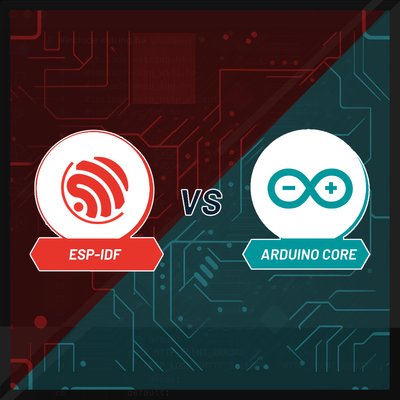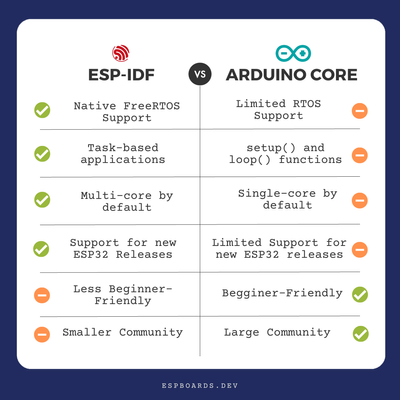
ESP-IDF vs Arduino Core: Which Framework to Choose in 2023
ESP-IDF (ESP IoT Development Framework) versus ESP Arduino core. Understand the difference and choose the development tools that suits your project best
ESP32 Development Frameworks #
When it comes to developing applications for ESP microcontrollers, there are two main frameworks to choose from: ESP-IDF and ESP Arduino Core.
While both frameworks have their advantages and disadvantages, in this post we will be exploring why should we choose ESP-IDF over ESP Arduino Core or vice-versa.
We will compare the two frameworks, highlight the benefits of using each framework and provide recommendations based on the specific needs and preferences.
What is ESP-IDF? #
ESP-IDF, or Espressif IoT Development Framework, is an official development framework for ESP32 series of microcontrollers.
The ESP IDF framework provides a set of libraries, tools, and APIs for developing ESP32 microcontroller based applications. It offers a wide range of features, commonly needed for the IoT applications and is designed to provide a comprehensive and flexible platform.
One of the main advantages of ESP-IDF framework is that it fully supports both standard C and standard C++ programming languages, which allows to write efficient, high-performance code.
Additionally, ESP-IDF provides a set of features and capabilities for building IoT applications, such as:
- ✅ Support for Wi-Fi and Bluetooth connectivity
- ✅ Rich set of drivers for various sensors, peripherals, and communication protocols
- ✅ Support for over-the-air (OTA) updates and secure boot
- ✅ Support for FreeRTOS, a real-time operating system for microcontrollers
One of the most exciting features of ESP-IDF is the ESP Rainmaker, a development platform for building cloud-connected devices.
You can find more information about ESP-IDF here:
- 🔗 ESP-IDF Github: https://github.com/espressif/esp-idf
- 🔗 ESP-IDF Programming Guide: https://docs.espressif.com/projects/esp-idf/en/latest/esp32/
What is ESP Arduino Core? #
ESP Arduino Core is a software development kit (SDK) designed to simplify the process of programming the ESP32 and ESP8266 microcontrollers by using the Arduino programming language and platform.
The Arduino platform has become popular for its ease of use and beginner friendly interface. And the ESP Arduino Core brings these advantages to the ESP32 and ESP8266 microcontrollers. It allows to use the same Arduino programming language and development environment, including the Arduino IDE, to write code for the ESP32 and ESP8266 microcontrollers. This makes it easy for beginners and hobbyists to get started with these microcontrollers, especially if you used the Arduino before, without having to learn a new toolset.
ESP Arduino Core includes a range of libraries and APIs that make it easy to work with the hardware of ESP32 and ESP8266, a variety of sensors and communication protocols. These libraries cover everything from basic input/output operations to more advanced functions such as WiFi or Bluetooth communication and cryptography.
However, should remember that the Arduino implementation of the C/C++ programming languages used in the Arduino is not the full version of the language. The Arduino platform uses a simplified version of the C/C++ language that is tailored specifically for the needs of microcontroller based projects. This can sometimes limit the functionality and flexibility of the code that can be written. In contrast, ESP-IDF provides a more complete implementation of C and C++ that allows developers to take full advantage of the programming language.
You find ESP Arduino core and more information on GitHub:
- 🔗 Arduino core for ESP32, ESP32S2, ESP32S3 and ESP32C3: https://github.com/espressif/arduino-esp32
- 🔗 Arduino core for ESP8266: https://github.com/esp8266/Arduino
ESP-IDF vs. ESP Arduino Core: Which to Choose? #
When it comes to choosing between ESP-IDF and ESP Arduino Core, there are a few key differences to keep in mind.
As we already mentioned, the ESP-IDF supports full C and C++ programming languages, which allows to take the full advantage of features C/C++ provides. While Arduino platform also supports C and C++, it is worth noting that it is not a full implementation of these languages.
In addition, ESP-IDF offers a variety of tools and features that are specifically designed for IoT development with ESP32 and ESP8266 microcontrollers, including the Over-the-Air (OTA) firmware updates. Even though OTA updates are also possible with ESP Arduino Core, the process is not as streamlined as with the ESP-IDF.
The main advantage of ESP IDF is the support new versions of ESP32 microcontrollers and features. As both the ESP-IDF is made by Espressif exactly for ESP32 and ESP8266 microcontrollers, when they release a new version of ESP32, they make sure that it is fully supported by the ESP-IDF Framework.
For example, currently the ESP32-C5 and ESP32-C6 are not officially supported by the ESP Arduino Core and can already lead to problems. For instance, if you need your projects to use the 5 GHz WiFi.
Overall, the ESP-IDF has several features that are not available or has worse support in the Arduino Core, including:
- ✅ Native support for FreeRTOS
- ✅ More efficient memory management and debugging tools
- ✅ Better support for multi-core CPUs
- ✅ More frequent updates and faster adoption of new ESP microcontroller versions
- ✅ Support for more advanced hardware features, such as Bluetooth, Wi-Fi, and low-power modes
Considering this, the ESP-IDF is more powerful and flexible option for users and projects that require more advanced hardware features, more efficient resource management, wants to use the newest releases of ESP32 versions and take the full advantage of the microcontroller.
Also, even though the Arduino provides more user-friendly interface for programming microcontrollers, it is still C++ under the hood. So if you already have experience with the Arduino, the switch to ESP-IDF should not be difficult, as it is the same programming language after all.
And the smaller community of ESP-IDF shouldn't scare you at all. The community is constantly growing and picking up speed, or personally I would say it has already picked it up. As the ESP-IDF was released around 5 years later, it needs time to catch up, but with the exciting releases of new features from Espressif, more resources on the internet and more people using it for their projects, it will surely do so in no time.
If you would decide to give the ESP-IDF Framework a try, you can find instructions in our post about getting started with ESP-IDF in Visual Studio Code.
Conclusion #
Overall, both ESP-IDF and ESP Arduino Core have their own strengths and weaknesses when it comes to developing applications for ESP microcontrollers.
However, if you want a more powerful and feature-rich development environment that can fully utilize the capabilities of the ESP microcontrollers and support the newest releases of ESP microcontrollers, then ESP-IDF is the way to go. With its support for full C++, faster updates and feature releases, ESP-IDF provides a better development experience for advanced users.
That being said, if you are already familiar with Arduino programming and don't require advanced features, then ESP Arduino Core is still a viable option for developing applications for ESP microcontrollers.
Ultimately, the choice between ESP-IDF and ESP Arduino Core depends on your specific needs and preferences.
